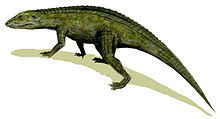Crocodyliformes
| Crocodyliformes Temporal range: Late Triassic–Recent,
| |
|---|---|

| |
| Protosuchus, an early crocodyliform | |
| Scientific classification | |
| Domain: | Eukaryota |
| Kingdom: | Animalia |
| Phylum: | Chordata |
| Class: | Reptilia |
| Clade: | Archosauria |
| Clade: | Pseudosuchia |
| Clade: | Crocodylomorpha |
| Clade: | Solidocrania |
| Clade: | Crocodyliformes Benton & Clark, 1988 |
| Clades | |
|
See text. | |
Crocodyliformes is a clade of crurotarsan archosaurs, the group often traditionally referred to as "crocodilians."
The clade Crocodyliformes was first named by Clark in 1988, in a paper written by James M. Clark and Michael J. Benton. Benton and Clark had argued that all traditional names for well-known groups of animals should be restricted to their crown clades, that is, used only for natural groups comprising all living members of any given lineage. This posed a problem for the crocodilians, because the name Crocodylia, while used in various ways by various scientists, had always included not only living crocodilians but many of their extinct ancestors known only from the fossil record.[1]
Benton and Clark's solution to this issue was to restrict the name Crocodylia to the group containing modern alligators, crocodiles, and gharials, plus any extinct members of those specific families. The traditional group "Crocodylia" was replaced with a new name, Crocodyliformes, which included many of the extinct families the new definition left out. Clark and Benton did not initially provide an exact definition for Crocodyliformes, but in 2001 Paul Sereno and colleagues defined it as the clade including Protosuchus richardsoni and the Nile crocodile, plus all descendants of their common ancestor.[2]
Chris Brochu agreed with the assessment that Crocodylia as a name has never had stable contents, and that a series of clades leading up to the crown group (including Crocodyliformes and the slightly more inclusive clade Crocodylomorpha) was a good solution.[3] However, in a 2008 paper Benton and Jeremy Martin, the authors reversed the previous opinion (co-authored by Benton) that Crocodylia should be restricted to the crown group, suggesting that Crocodyliformes should be considered a synonym of a more inclusive Crocodylia, and thus replaced.[4]
Phylogeny
The cladogram below illustrates the relationships of crocodyliformes, based on an overview by Martin and Benton, 2008.[4]
| Crocodyliformes |
| ||||||||||||||||||||||||||||||
References
- ^ Benton, M.J. and Clark, J.M. (1988). "Archosaur phylogeny and the relationships of the Crocodylia." Pp. 295–338 in Benton, M.J. (ed.), The phylogeny and classification of the Tetrapods, volume 1. Oxford: Clarendon Press.
- ^ Sereno, P.C., Larson, H.C.E., Sidor, C.A. and Gado, B. (2001). "The giant crocodyliform Sarcosuchus from the Cretaceous of Africa." Science, 294: 1516–1519.
- ^ Brochu, C.A. (2003). "Phylogenetic approaches toward crocodylian history." Annu. Rev. Earth Planet. Sci., 31: 357–397.
- ^ a b Martin, J.E. and Benton, M.J. (2008). "Crown Clades in Vertebrate Nomenclature: Correcting the Definition of Crocodylia." Systematic Biology, 57: 1,173 — 181.
